Movies & Shows
 |
 |
 |
 |
 |
 |
 |
Anti-colonialism, Shamanism & Feminism
Frozen 1 (2013) and Frozen 2 (2019)
Salwa Bachar
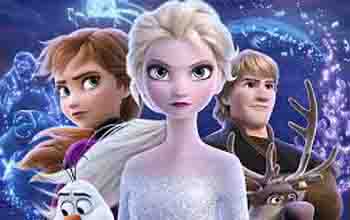
Frozen 2: strong feminist women who lead the way and a weak stupid man
The two main characters of Frozen 2, members of a fictional European royalty, have to “right the wrong” of their colonial ancestors who took advantage of the peace-loving indigenous people, murdering them and exploiting their resources in their quest for wealth and power.
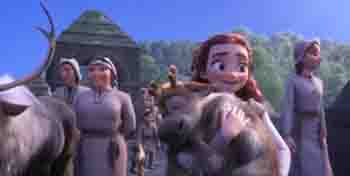
An idyllic picture of the Northundrian tribal village
It should also be noted that presenting indigenous tribes as peace-loving people is actually far from reality. It is known that among the Indians there is a high rate of murder and it is well documented that many indigenous tribes engaged in gruesome practices such as wearing the scalps of their enemies as trophies, dismembering and eating children, bestiality, human sacrifices, to name a few.
Shamanism
One integral part of Tribalism is shamanism, and though it is not explicitly stated in the movie, it seems clear that Elsa’s journey is one to become a shaman.
One spirit that Elsa particularly likes is Bruni, the fire spirit that takes the form of a salamander. It should be noted that salamanders have always been a symbol of witchcraft and the occult. So, early on in the movie, an association between Elsa and the occult is already present.
The shaman connection is made explicit when Elsa learns that she is the fifth elemental spirit, who is defined in the movie as “a mediator between humans and the magic of nature.” This is actually the exact definition of a Sami shaman or noaïde: “The noaïde served as healer, protector and prophesier for the siida, the basic Sami social unit, comprised of multiple extended families living and working together. The noaïde also served as mediator between the multiple worlds that exist in the traditional worldview.” (Read more here)
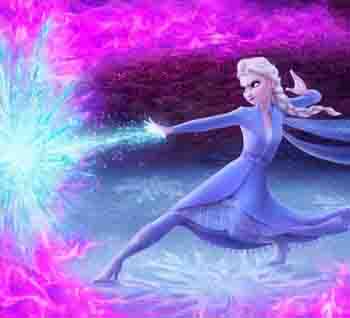 '
'
Elsa answers a call and eventually is reborn into her full 'magical' power, like a witch
All of this happens in the movie: Elsa hears the call of a mysterious voice, she follows it into a place of solitude, she submits to the elemental spirits, and she dies and is born again from the water (a kind of anti-baptism, as a friend put it).
Add this to the fact that she leaves Arendelle to live with the Northuldra as the “mediator between humans and nature,” thus becoming the protector of the Enchanted Forest and having a prophetic sense, and we have Elsa fulfilling all of the requirements to be a Sami shaman.
A last but poignant reference to shamanism is the eerie song "Vuelie" composed for the movie. This song is a yoik, a type of rhythmic vocal chant of the indigenous Sami people that plays an integral part in shamanic rituals. (2)
"Vuelie" is used for the opening of Frozen 1, and also makes a very active reappearance in Frozen 2, in which the Northuldra men and women sing and beat their staffs on the ground, creating a rhythmic drumming that apparently mimics the sounds of a Sami shamanic ritual.
Feminism, androgynism
The leading characters of the movie are young women, while the supporting characters in the movie are men, if you can count the magical snowman Olaf as a man. The only real male character is Kristoff, who is portrayed as uncivil, buffoonish, weak – only there to serve Anna (Elsa’s sister) and follow her wherever she goes.
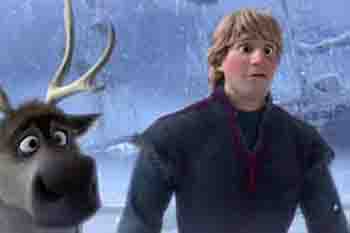
The one lead male character is a love-sick 'big boy'
At the end, he proposes, Anna accepts, yet their relationship remains ambiguous: Anna becomes Queen and Kristoff – a simple peasant who sells ice for a living – continues to do the same, like a servant of the Queen. No wedding ceremony is ever seen and Kristoff does not appear to take any part in ruling Arendelle.
Besides the movie’s feminist message, there is also an androgynist hue present. The Northuldra leader, Yelana, is supposed to be a woman, but it is actually hard to tell the real gender of the character. He/she is presented with long white hair that is off the face and partially braided, but the face and body is clearly masculine, except for the chest area.
These portrayals of men and women only serve the agenda of Feminism, which seeks to invert the natural order of the sexes: The women become the strong and decisive leaders while the men are emotional, weak and dependent on the women.
Conclusion
With all of these things considered, what is the viewer left with after watching Frozen 2? I believe that:
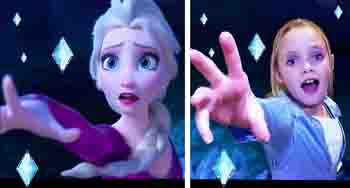
An initiation into witchcraft: Girls admire and mimic the magical powers of Elsa,
- The viewer is encouraged to embrace indigenous Tribalism, its way of life and its Paganism, while seeing Colonialism and “the white man” as the enemy;
- He becomes accustomed to Paganism and Occultism, which leads him to believe that magic is normal and even desirable, while longing for a shaman to lead him;
- He is induced to accept Feminism and Androgynism as normal.
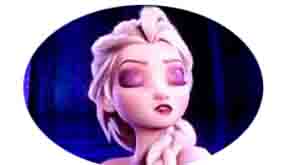
The matured Elsa, fully aware of her 'powers'

- “The processes of initiation into shaman status ... both involved training by an experienced shaman, self-induced physical and spiritual hardships to reach spiritual enlightenment, and the acquisition of helper spirits [like the elemental spirits in the movie] through their own ability to contact the spiritual realms. ‘The initiation of a (Sami) shaman followed to a great extent the pattern typical of spiritual metamorphosis: the response to a call, withdrawal into solitude, submission as a pupil to a master, and metaphorical death and rebirth’ (Walter and Fridman 2004 [on p. 501, here]) ... Once the Noaidi or Angakoq has been initiated into his role as shaman, he has learned many different methods of achieving this transcendental state, which allows him to move freely [as a “bridge”] between the spiritual realms and the living realm…” (Original here)
- “Sami indigenous religion was a world-view and also a shamanistic form of worship in which drumming and traditional chanting, yoiking, were of singular importance. ... As part of the shamanic experience, the noaïde and others yoik; yoiking is the Sami rhythmic chant-song used for a variety of purposes, but in the context of shamanic rituals, serves in part as a trance conjuration tool. ... Yoiking is a manifestation of the aámi’s wish to reify or call someone (or thing) into being.” (Original here)
Posted January 17, 2020
______________________
______________________





